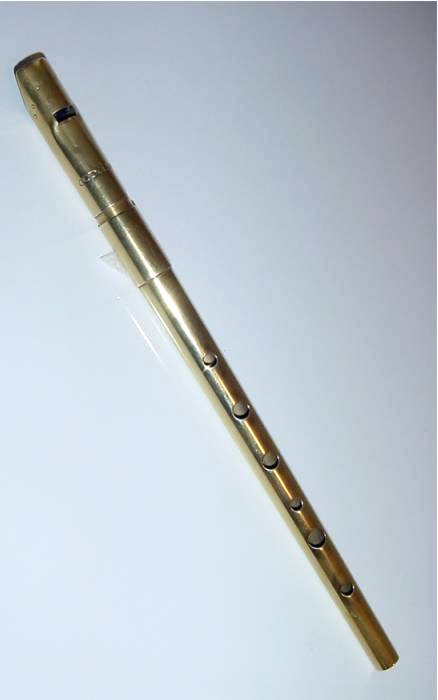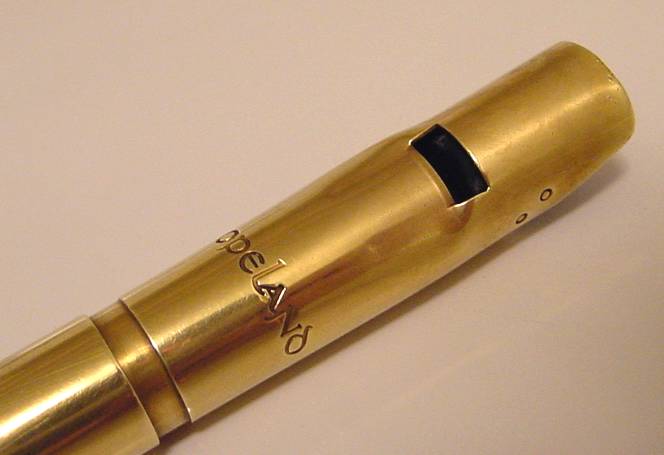Copeland Soprano D whistle Review
(Review written November 2004)
- Preface
- I've had this whistle a long time. Around a couple of years, I guess. I can't believe I haven't reviewed it yet. In fact, this is the whistle that replaced my Silkstone as my favorite whistle. For years, I ran away from Copelands--not because anything was wrong with them, but because I wanted to be "different". In the circles I played in, Copelands were assumed to be the pinnacle of tinwhistling goodness, and so I wanted to find something just as good but different, so that I wouldn't be just like everyone else. Eventually, I gave in to the dark side, and got one myself. ;) I still didn't play it that much until I lost my Burke whistle in a friend's couch for a month. Then, I was forced to get used to it out of necessity, as it was one of the whistles I had to rely on for gigs. I'm glad I overcame the obstacles, as it's a very fine whistle indeed.
- At a Glance
- Whistle Reviewed
- Copeland Soprano D whistle
- Models Available
- Tunable, lots of keys (D, E, Eb, C, A, Bb, low G, low F, low D)
- How Acquired
- Purchased used
- Construction
- Conical bore, brass, nickel, or sterling silver (silver not available in all keys).
- Price at Time of Review (in US Dollars unless otherwise noted)
- $300.00 for a brass D, E, or Eb.
- Available From
-
Ebay (Note that Michael has since closed up shop. He occasionally puts up whistles on ebay)
- Appearance
- Copeland is the "king of high-end tinwhistles" to many people. It has a distinctive conical-bore look. The low D's have a very distinctive wind shield (at least I assume that's what it is) on the mouthpiece. It's very professionally crafted. The brass whistles definitely leave a brassy smell and taste on your hands and lips after playing for long periods of time, which some people may find distasteful. They also tarnish fairly quickly. When I played mine at the Texas Renaissance Festival in 2003, I would polish it every week to keep it shiny and new. I'm glad I did, because I lost it out there one weekend, and a mother turned it in to lost and found because it "looked expensive". I'm not so sure she'd have done that if it was all tarnished and old looking. Whew!
-

Here you can see the whole whistle, with it's distinctive head shape and conical bore.
Here's a close-up of the head. You can see the stamped-in Copeland name, and the pressed labium ramp. This makes the sides of the whistle flare out a little here, giving it that 'bulge'. You can also see two of the pins holding in the Delrin mouthpiece. Not shown is the curved windway (much like a Susato or Silkstone).
Here's the tuning slide area. It's a simple brass-in-brass arrangement. The headpiece gets narrower, and slides into a widened area of the body. I have read that these slides can tend to seize up if you let them sit for very long periods of time. I've never had it happen to me, since I move the slide around on a regular basis.
- Playing Characteristics
- This whistle has a very strong character. It has very little chiff, but it has that distinctive fluty nature that you get with conical bore whistles. It's that same kind of flutiness you can hear in a Clarke or Shaw (not taking the breathiness or chiff into account). That gives it a rich, full sound.
-
Sound clips of the whistle:
Road to Lisdoonvarna
Video clips of the whistle:
Garret Barrys (recorded 2017 on a nickel copeland)Volume: This whistle is fairly loud. It can sound overpowering in the 2nd octave, even though it's not the loudest whistle I own. I don't know if that's because of harmonics or what, but it can be a bit painful in the high A, B and 2nd register C. I know there are some variations in Copelands produced (both by design and simply as variants in individual whistles), and I think I got a slightly quieter one. That said, it's still pretty loud compared to an Oak or Walton's. At the Texas Renaissance Festival, I needed a super loud whistle for Maypole--It was a large open area, no amplification, trafficked by hundreds of talking people. This whistle nearly fit the bill; it couldn't fill the space when it was at it's noisiest, but otherwise worked well. When the guy selling Susatos tried to sell me one of his, for more volume, we sat down and played mine VS. his side by side, and the Copeland turned out to be a slight bit louder. I reminded him that he could be heard further than me because he had a hidden microphone and amplifier in his booth. ;)
Responsiveness: Pretty fast. This whistle has very good above-average response time. There are slightly faster responding whistles out there, but not by much.
Tuning: Except for the slight bit of breath gymnastics on C natural, the whistle is in tune from D to high B, though you have to push it a bit on the top notes. At the Houston session, the players there favored the intonation of this whistle over my first Burke Al-Pro and my Silkstone..then again, I have mentioned that it was already pre-accepted that the Copeland was the "king of whistles", so I can't say how much of this had to do with actual intonation, and how much had to do with pre-conceived notions about what a whistle should sound like. Like most good pro whistles, you can push the tuning around with your breath, which means it'll be harder for beginners to master the instrument. I've heard troubling reports that now that Copeland Woodwinds has a more factory production going, there is some quality control issues with their tuning. Luckily, that wasn't the case in my older version. But I know that they have good customer service and stand by their instruments. If you have issues with your Copeland, they'll try to fix it, even if you got it secondhand.
C-natural: OXXOOO produces an c-natural about 10 cents sharp of true. You can bring it into true by breathing softer, or use OXXXOO which is right on. I just breathe softer.
Hole size and placement: This whistle has holes are fairly standard spaced and sized. I only keep this category around because some few whistles have extremely weird hole spacing. This isn't one of them.
Air volume and pressure requirements: This whistle takes a lot of breath. That was my biggest challenge with the Copeland low D I had, and the same design is evident in the high D. It took a lot of getting used to. I found myself breathing a lot sooner than I expected, and I never seemed to have enough breath to get the phrases out the way I wanted. That said, it is something you get used to after a while, if you put yourself to the task. As for breath pressure, I can say this: this whistle demands confidence from the player. The second octave requires you to be sure of yourself and really attack the notes, or the whistle will chastise you by falling into the first octave or blowing a raspy goose honk at you. In other words, a good amount of pressure is required for this whistle to really come into it's own. It's like a wild stallion that, when mastered with a firm hand, is a great racehorse, but if treated with too much gentleness will run away from you. This is especially true in the top half of the second octave.
Clogging: This whistle gets fairly wet, but never really clogged on me. When it gets too wet, though, the top half of the second octave becomes much harder to control, squeaking or honking more readily. For this reason, I couldn't really use it exclusively at 4-hour gigs, and instead relied on it and my Silkstone to get the job done as a pair.
- Summary
- Very professional whistle. The high breath requirements, confidence needed, and loudness of the whistle may make it an extreme challenge for beginners. But for those who master it, it is a very satisfying whistle indeed.